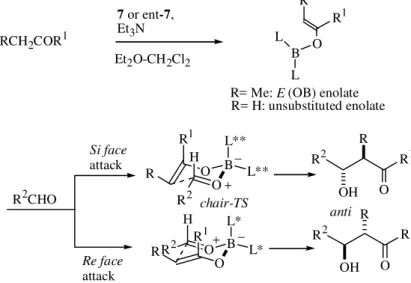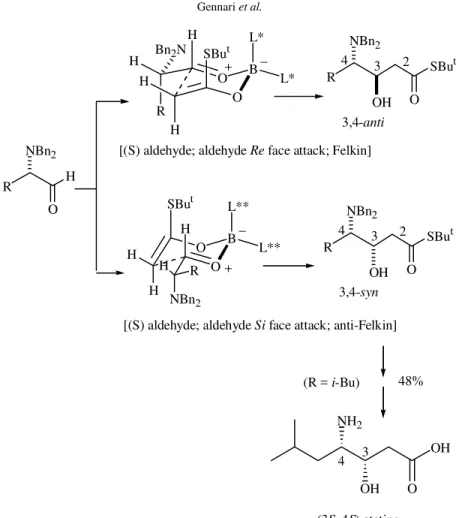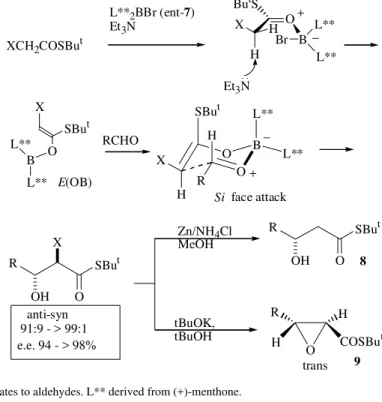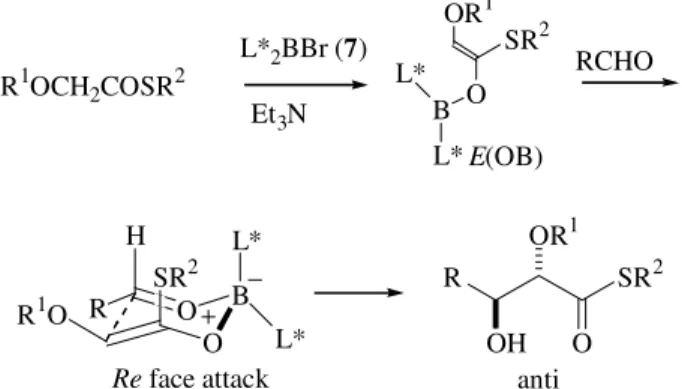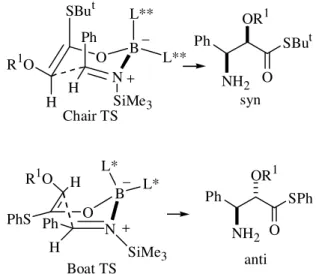Computer-Assisted Design and Synthetic Applications of Chiral
Enol Borinates: Novel, Highly Enantioselective Aldol Reagents
Cesare Gennari*,a, Simona Ceccarellia, Umberto Piarullib, and Karim Aboutayaba
a
Dipartimento di Chimica Organica e Industriale, Centro CNR per lo Studio delle Sostanze Organiche Naturali,Università di Milano, via G. Venezian 21, I-20133 Milano, Italy
b
Istituto di Scienze Mat. Fis. e Chimiche, Università di Milano, via Lucini 3, 22100 Como, Italy
Received: August 10, 1998
Descrevemos recentemente o desenvolvimento de um modelo quantitativo de estados de transição para a previsão da estereosseletividade em condensações aldólicas mediadas por boro. Este modelo fornece percepções qualitativas sobre os fatores, contribuindo para o resultado estereo-químico de uma variedade de reações de importância sintética. O modelo de campo de força foi utilizado para auxiliar na elaboração e preparação de novos ligantes de boro quirais derivados da mentona. Os enolatos de boro quirais foram empregados em vários processos estereosseletivos, incluindo a adição a aldeídos quirais e a síntese total, controlada pelo reagente, da (3S,4S)-estatina. Os enolatos quirais derivados a partir de tioacetatos α-halo e α-oxisubstituídos foram adicionados a aldeídos e iminas. A adição de iminas leva à síntese enantiosseletiva de aziridinas quirais, a síntese total formal da (+)-tioamfenicol, a uma nova e altamente eficiente síntese da cadeia lateral em C-13 do paclitaxel (taxol®) e a semi-síntese do taxol a aprtir da bacatina III. O resultado estereoquímico da adição das iminas foi racionalizado com o auxílio de estudos computacionais. Reações de adição enantiosseletiva de enolatos de boro quirais derivados do tioacetato foram empregados com sucesso a aldeídos ligados à fase sólida, fornecendo produtos aldólicos em rendimentose enantiosseletivi-dades comparáveis às condições usuais em solução.
We have recently described the development of a quantitative transition state model for the prediction of stereoselectivity in the boron-mediated aldol reaction. This model provides qualitative insights into the factors contributing to the stereochemical outcome of a variety of reactions of synthetic importance. The force field model was used to assist the design and preparation of new chiral boron ligands derived from menthone. The chiral boron enolates were employed in various stereoselective processes, including the addition to chiral aldehydes and the reagent-controlled total synthesis of (3S,4S)-statine. The chiral enolates derived from α-halo and α-oxysubstituted thioacetates were added to aldehydes and imines. Addition to imines leads to the enantioselective synthesis of chiral aziridines, a formal total synthesis of (+)-thiamphenicol, and a new highly efficient synthesis of the paclitaxel (taxol®) C-13 side-chain and taxol semisynthesis from baccatin III. The stereochemical outcome of the addition to imines was rationalised with the aid of computational studies. Enantioselective addition reactions of the chiral boron enolate derived from thioacetate have successfully been applied to solid phase bound aldehydes to give aldol products in comparable yields and enantioselectivities to the usual solution conditions.
Keywords:chiral boron enolates, enantioselective aldol reactions, statine, paclitaxel
Review
Transition State Modeling and Design of
New Boron Ligands
We recently described a force field model for the aldol reactions of ketone derived enol borinates with aldehydes. This force field is based on MM2, and on new parameters developed from ab initio calculations on the cyclic aldol transition structures (e.g. chair 1 and boats 2, 3; Fig. 1). The model reproduces the aldehyde Si: Re selectivity for the syn selective aldol reactions of a range of chiral Z enol bori-nates, as well as for the anti selective reactions of E eno-lates. The force field model suggested that the following factors were important in determining the stereoselectivity of the chiral boron-ligand mediated reactions: (a) the con-formational rigidity of the boron-ligand, (b) the relative orientation of the ligands with respect to the transition structure core, and (c) the relative orientation and restrained rotation around the B-C bonds of one ligand relative to the other1,2.
Based on this information, it was decided to search for conformationally locked systems. The case of cis -1,2-ethylisopropylcyclohexane appeared as an interesting ex-ample of conformational lock based on the avoidance of (+/-) double gauche pentane interactions (Fig. 2). There is only one conformation of the chair and of the side chains (4) that does not possess any (+/-) double gauche pentane interactions, while any other rotamer is higher in energy. The terminal methyl group of the ethyl side chain was substituted with a boron atom. For reasons of synthetic accessibility (see below), an extra equatorial methyl group was added to the ligand (5, Fig. 2), which did not alter the computed stereoselectivity.
After running the conformational search of a Si:Re face selection in an E(OB)-enol borinate reaction (for nomencla-ture see Ref. 3) leading to an anti aldol, we were delighted to discover that the new chiral enolates showed a distinct stereoselectivity in the computational run, surpassing by far Ipc (isopinocampheyl) or any other designed reagent4.
The Menthone Derived Boron Reagents
The synthesis of the new reagents 6 and 7 (Fig. 3) took considerable effort to develop due to the need for separation from diastereomeric dialkylboranes formed in the hydrobo-ration step. The minor diastereomeric haloboranes were shown both computationally and experimentally to be low-stereoselective reagents for the aldol reaction. Eventually the borane was purified by crystallization in ethyl ether at low temperature. The reagent is quite stable and is currently prepared uneventfully and stored as a stock solution in methylene chloride in the freezer.
Syn aldols, in boron enolate chemistry, are easily ob-tained with good enantioselectivity from chiral Z (OB)-eno-lates because they have only access to a single transition structure, chair 1. High selectivity for anti or unsubstituted aldols is comparably more difficult to achieve because unsubstituted enolates and (partly) E(OB)-enolates may adopt a variety of transition structures, namely chair 1, boat 2, and boat 3 (Fig. 1). This competition among transition structures of similar energy (usually many conformers for each transition structure core-conformation 1, 2, and 3) makes the stereochemical control of the reaction much more difficult to obtain. The chiral E enol borinates derived from the reagents shown in Fig. 3gave rise to ketone-de-rived anti-aldols, which had eluded earlier attempts at
B O O
H
H O B
H O
H B
O H
H O
Unsubstitued enolates [E(OB)-enolates]
Z(OB)-enolates
E(OB)-enolates Unsubstituted enolates
chair (1) boat A (2) boat B (3)
Unsubstitued enolates [E(OB)-enolates] Accessible to: Accessible to: Accessible to:
Figure 1. All-hydrogen substituted ab initio transition structures for boron enolate aldol addition.
Figure 2. Lowest energy conformation of compound 4 and boron ligand 5. Y = Me, R = H 4
L
Y = B, R = Me, L = 5
H R
H
H H
Me Me
H YH
effective asymmetric synthesis via direct aldol-type con-densation. Although the enantioselectivity was lower than computer-predicted (the aldol force field is not as calibrated with E enolates as it is with Z enolates), the enantiomeric excesses (74-88% e.e.; R = Me; R1 = alkyl, aryl) were the highest reported for such transformations (Fig. 4). The reagent proved effective also with methyl ketone enolates leading to unsubstituted aldols, although with lower enan-tiomeric excesses (55-76% e.e.; R = H; R1 = alkyl, aryl). Particularly noteworthy were the results with thioester-de-rived anti (≥ 98% e.e.; R = Me, R1 = SBut) and unsubsti-tuted aldols (87-97% e.e.; R = H, R1 = SBut) (Fig. 4). The
absolute configuration of the aldol products is consistent with chair transition structures, as suggested by the com-puter model (Fig. 4) 4-6.
Reagent Control. Total Synthesis of
(3
S
, 4
S
)-Statine
In the reaction of chiral enolates with chiral aldehydes the intrinsic diastereofacial selectivities of the two chiral components are either matched or mismatched. If the alde-hyde (substrate) intrinsic selectivity is moderate and the enolate (reagent) selectivity is very high, reagent control is obtained. Boron enolates derived from 7 or ent-7 show a high degree of reagent control in reactions with chiral aldehydes, and the efficiency of double asymmetric synthe-sis reflects the level of enantiomeric excess of the reactions with achiral aldehydes [thiopropionates (≥ 98% e.e.) ≥ thioacetates (87-97% e.e.) > ethylketones (74-88% e.e.)]. Almost complete reagent control was obtained in the addi-tions of thioester enolates to protected lactic aldehyde (thiopropionate addition: desired diastereomer ≥ 99%; thioacetate addition: desired diastereomer 93-94%) and protected glyceraldehyde (thiopropionate: 95-99%; thioacetate 96-97%). The results were slightly worse with α-methyl-β-benzyloxypropionaldehyde (thiopropionate 65-95%; thioacetate 68-96%)7.
Additions to N,N-dibenzylamino aldehydes were also highly diastereoselective: the chiral boron enolate of t-butylthioacetate derived from ent-7 was able to overcome the inherent substrate preference for the Felkin-type product (3,4-anti) observed with achiral enolates. It is worth noting that in the ‘‘matched’’ cases the 3,4-anti: 3,4-syn diastereomeric ratios are ≥ 98.2:1.8, while in the ‘‘mismatched’’ cases the 3,4-syn: 3,4-anti ratios are ≥ 95.4:4.6. These results indicate that it is possible to obtain either the 3,4-anti or the 3,4-syn adduct with very high diastereoselectivity by simple variation of O
B X
B X
O
6 , X = Cl 7 , X = Br
(+) menthone
ent-6 , X = Cl ent-7 , X = Br (-) menthone
a-c a-c
Figure 3. The menthone derived boron reagents. a) Ph3P=CH2; b) XBH2 -SMe2, CH2Cl2; c) crystallization, Et2O, -30 °C.
R1 R
B O
O B O
H L*
R1
R B L**
L* R2
R
O L** R1
H
O R2
L
L
chair-TS Si face
attack
R= Me: E (OB) enolate
anti
7 or ent-7, Et3N RCH2COR1
Et2O-CH2Cl2
R2CHO
R= H: unsubstituted enolate
Reface
attack
+
+ _
_ R2
R1
O R
OH
R2 R1
O R
OH
the chiral boron ligand configuration [L* derived from (-)-menthone, L** from (+)-menthone; Fig. 5]8. (3S, 4S )-Statine, the main component of the specific aspartic pro-tease inhibitor pepstatine,was synthesized in a few steps starting from L-leucine (Fig. 5)8.
Chiral Boron Enolates Derived from
α
-halosubstituted Thioacetates
We have recently reported that the enolates derived from α-halo thioacetates (X = Cl, Br) and the chiral boron reagent 7 or ent-7 (Fig. 6)9 react with aldehydes to give
α-halo-β-hydroxy derivatives with high diastereo-(anti:syn 91:9 > 99:1) and enantiocontrol (e.e. = 94 -> 98%). Anti α-halo-β-hydroxy thioesters were trans-formed in high yield into β-hydroxy thioesters 8 (Zn/NH4Cl/MeOH) or into trans glycidic thioesters 9
(tBuOK/tBuOH).
The addition of the chiral boron enolates derived from tert-butyl α-halothioacetate (X = Cl, Br) to achiral silyl imines leads to α-halo-β-amino thioesters. N -trimethyl-silylimines were reacted with the E(OB) enolate [L** derived from (+)-menthone] to form α-halo-β-amino thioesters, which were isolated in 77-89% yield as
hydro-chloride salts 10 (Fig.7)10. The diastereoselectivity of the reaction (syn: anti 92:8 - ≥ 99:1) and the enantiomeric ratios of the major syn products (97:3 - ≥ 99.5:0.5) are high, particularly for X = Br (syn:anti ≥ 99:1; e.e. ≥ 97%). Simple reduction with LiAlH4 of the α-halo-β-amino thioesters 10
gave non protected cis chiral aziridine alcohols 11. Azirid-ine (11b) is a key intermediate for the synthesis of the broad spectrum, antibacterial, synthetic antibiotics (+)-thiam-phenicol and (-)-florfenicol11.
It is interesting to note that the stereochemistry of the imine (trans) determines the syn stereochemical relation-ship in the aldol product 10. In fact, the absolute configu-ration of 10 is consistent with a chair transition structure featuring preferential attack on the imine Re face (Ar axial, Fig. 7). We may also point out that in the aldehyde case, the R group can adopt an equatorial position (aldehyde Si face attack) which eventually leads to the anti relationship between the hydroxy and the halogen groups (Fig. 6).
Chiral Boron Enolates Derived from
α
-oxysubstituted Thioacetates
Our chiral glycolate enolates are able to impart excel-lent diastereo- (anti-syn≥ 97:3) and enantiocontrol (e.e. = R
H Bn2N
OH O
B
NBn2
O SBut R
H
L* O
L* H
SBut
H
[(S) aldehyde; aldehyde Re face attack; Felkin] +
_
3 3
2
O B
H
L** O
L** SBut
H
H
R
NBn2 H
OH NBn2
O SBut R
_
[(S) aldehyde; aldehyde Si face attack; anti-Felkin] 3,4-anti
2
NBn2
R
O H
OH NH2
4
OH 3,4-syn
O +
4
(3S, 4S)-statine 3 4
48% (R = i-Bu)
94-97 %), see Fig. 89. The following is noteworthy: a) the enolization preferentially results in the formation of E (OB)-enolates, as implied from the high anti-syn ratios observed in the aldol products; b) the enantiomeric and the anti-syn ratios are independent of the type of R1 and R2 substituents (R1 = TBDMS, Bn; R2 = Ph, But); c) the
absolute configuration of the aldol products is consistent with chair transition structures featuring preferential at-tack on the aldehyde Re face [L* derived from (-) men-thone].
Semisynthesis of Paclitaxel (Taxol
®)
Paclitaxel (12) is considered the most promising cancer chemotherapeutic agent and has recently been approved for treatment of metastatic ovarian and breast cancer12.Central to all synthetic strategies for paclitaxel is the synthesis and attachment of the C-13 side chain to the baccatin III nu-cleous, since the presence of this side chain has proven to be essential for the biological activity of paclitaxel. The chemical complexity of paclitaxel dictates that its commer-cial production by total synthesis is not likely to be eco-nomical, while the naturally derived 10-deacetylbaccatin _
10
11 LiAlH4, THF, 0°C
86-91%
a Ar = Ph
b Ar = p-MeS-C6H4
E(OB)
+
Re face attack _
N B
H
L** O
L** SBut
Ar
X
H +
Ar N TMS
X
OBL**2 SBut
Ar
OH
H H
N H SiMe3
(+)-thiamphenicol and (-)-florfenicol ref. 11
Ar
COSBut
NH3Cl
X
Figure 7. Additions of α-haloacetates to N-trimethylsilylimines. L** derived from (+)-menthone.
R SBut
OH X
O SBut
B O L**
L** X
O ButS
H X H
B L**
L** Br
RCHO
Et3N
Si face attack
anti-syn 91:9 - > 99:1
_
E(OB)
_
O B
H
L** O
L** SBut
H
X
R XCH2COSBut
Zn/NH4Cl MeOH
e.e. 94 - > 98%
+
tBuOK, tBuOH
trans L**2BBr (ent-7)
Et3N
8
9
+
R SBut
OH O
O H
R H
COSBut
III (13a, Fig. 9) is readily available in relatively high yield from the needles of the European Yew T. baccata. Prepa-ration of quantities of paclitaxel economically by a semi-synthetic approach which involves the condensation of protected 10-deacetylbaccatin III (13b,c) with suitably pro-tected N-benzoyl-(2R,3S)-3-phenylisoserine (14), provides
an alternative source of this important natural product and the access to semisynthetic analogs.
We have developed a very simple, new and straightfor-ward approach to the paclitaxel side chain using the imine addition reaction of thioester derived boron enolates bear-ing chiral ligands.13,14 The side chain is assembled in one
single step with the correct relative (syn) and absolute stereochemistry (2R, 3S). The desired compound (16) was isolated practically pure by simple solvent extraction with-out the need for chromatography (Fig. 10). The overall yield is 60% (starting from 15), and the stereochemical control is high (syn:anti≥ 96:4; e.e. ≥ 96%).Oxazolidine formation occurs using 2-methoxypropene and pyridinium toluene-4-sulfonate in toluene to give (17) (≥ 90%) and the small amount of the unwanted anti diastereomer is re-moved in this step via chromatography (the anti compound does not cyclize under these conditions).
Following a different approach, the desired compound (19) was obtained in an overall yield of 71% (starting from 18), with an anti:syn ratio ≥ 97:3, and ≥ 95% enantiomeric purity (Fig. 11)13,14. Compound 19 was then treated with
aqueous HF in acetonitrile, and the resulting crude com-pound 20 (100%, anti:syn 97:3) was cyclized using thionyl chloride in refluxing 1,2-dichloroethane.
SR2
B O L*
L* OR1
O B O
H L*
SR2 R R1O
L*
RCHO
Re face attack
E(OB)
anti R1OCH2COSR2
L*2BBr (7)
Et3N
+
_ R SR2
OH OR1
O
Figure 8. Additions of α-oxyacetates to aldehydes. L* derived from (-)-menthone.
O R1O
OR
O HO
AcO H BzO R2
O
O NH
OH O
Ph
7 10
13
(14) (12) R = H; R1 = -COCH
3; R2 = 14
(13a) R = R1 = H; R2 = OH
(13b) R = -SiEt3; R1 = -COCH3; R2 = OH (13c) R = R1 = -CO-OCH
2CCl3; R2 = OH
Figure 9. Paclitaxel (12), free (13a) and protected (13b,c) 10-deacetyl-baccatin III, N-benzoyl-(2R,3S)-3-phenylisoserine (14).
OH
NH O
Ph SBut
PhCO
O
N O
Ph SBut
PhCO a-f
(16)
g
(15)
(17) PhCOOCH2COSBut
Figure 10. a) L**2BBr (ent-7) derived from (+)-menthone, Et3N, CH2Cl2, Et2O, -25 °C, 7 h; b) PhCH=NSiMe3, -78 °C to -5 °C; c) pH 6 phosphate buffer quenching, CH2Cl2 extraction, evaporation; d) 1:1 (v:v) MeOH: 1 N aqueous HCl, RT; evaporation; e) solid washed with Et2O; f) pH 8 aqueous phosphate buffer, MeOH, RT; CH2Cl2 extraction (60% yield over steps a-f); g) CH2=C(OMe)Me, pyridinium toluene-4-sulfonate, toluene, 80 °C, ≥90%.
OTBDMS
NH O
Ph SPh
PhCO
(20) OH
NH O
Ph SPh
PhCO
f g
(18)
a-e
(19)
O
N O
Ph SPh
Ph H
H TBDMS-OCH2COSPh
(21)
Oxazoline formation occurred with complete inversion of sterochemistry at the C-2 stereocenter to give (21) (65% yield), and the traces of the unwanted syn diastereomer were removed in this step via chromatography (the syn compound does not cyclize under these conditions). Thioesters 17 and 21 were attached directly to the baccatin nucleous. By treatment of a mixture of protected baccatin III [7-TES,10-Ac (13b) or 7,10-di-Troc (13c)] and oxa-zolidine (17) or oxazoline (21) in THF at 0 °C with LiN(SiMe3)2, the 13-O acylated compounds were obtained
in high conversion and yield (74-75% from 17 and 89-90% from 21). The 13-O acylated compounds were deprotected to give paclitaxel (12) in high yields13,14.
From the above results, and from many other not re-ported, it is clear that the stereochemical outcome of the aldol additions to imines is strongly dependent on the type
of thioester used (COSPh vs. COSBut), contrary to the results using the same boron reagents and aldehydes (Fig. 8)9,while the role of the oxygen protecting group is rela-tively minor. The stereochemical outcome can be rational-ized using chair vs. boat transition structures (Fig. 12). Ab initio MO calculations (3-21G basis set) featuring the ad-dition of the BH2 enol borinate derived from acetaldehyde
to formaldehyde-imine have recently shown that two com-peting cyclic transition structures are likely to be important: the chair and the boat15.
Enantioselective Aldol Chemistry on Solid
Phase
Studies of organic synthesis on a solid support have witnessed an explosive surge of interest in the last few years. Much effort has been expended in the adaptation to the solid phase of the synthetic armoury of organic chem-istry. Solid supported strategies leading to the iterative synthesis of the most important biopolymers, namely pep-tides, oligosaccharides, and oligonucleotides are well es-tablished and have also been adapted to automation. However, a solid phase approach to polyketides, a class of biopolymers consisting of a 1, 3, 5, n-polyol chain with defined stereochemistry, has not yet been demonstrated.
Two different approaches, in principle, could be em-ployed for solid phase supported aldol chemistry: forma-tion of the enolate linked to the resin and reacforma-tion with an aldehyde in solution; or the immobilization of the aldehyde on the solid support and treatment with an enolate in solution. The second synthetic pathway allows for possible iteration of the aldol process towards a solid phase synthe-sis of polyketide-type structures, provided a conversion to another aldehyde is accomplished.
NH2 OR1
O Ph SBut
NH2 OR1
O Ph SPh B
N L*
L*
O
SiMe3 H
Ph R1O H
PhS
Boat TS anti +
_ N
B
H
L** O
L** SBut
Ph
R1O H
SiMe3 Chair TS
_
+
syn
Figure 12. Transition states for the enolate additions to imines. L* derived from (-)-menthone. L** derived from (+)-menthone.
O
H
OBL*2
StBu
O
OMe O
StBu
OH OH
B O Et2O, CH2Cl2,
-78 / -5 °C, 16 h
Cleavage + methylester
H2O2, MeOH,
Phosphate buffer, RT, 0.5 h
R
yields = 38-64% e.e. = 88-91%
L*2BO =
from (-) menthone [LINKER]
[LINKER]
We were attracted by the possibility of developing a stereoselective aldol protocol on solid phase bound alde-hydes using our thioester-derived chiral enolborinates bearing chiral ligands. These boron enolates have been shown to impart a strong reagent control in their reactions with chiral aldehydes (see above), which is required in order to control stereochemistry of the growing chain. Furthermore, the use of thioesters should enable easy con-version to the aldehyde for iteration.
Enantioselective addition reactions of the chiral boron enolate derived from thioacetate to solid phase bound alde-hydes have successfully been carried out with a variety of aldehydes and linkers, and giving rise to aldol products in yields and enantioselectivities comparable to the usual solution conditions (Fig. 13)16.
Acknowledgments
We thank the Commission of the European Union (TMR Network grant ‘‘Combinatorial catalysts’’ ERB-FMR XCT 96-0011) and Pharmacia & Upjohn for financial support. Graduate fellowship is gratefully acknowledged by S.C. (Pharmacia & Upjohn, Nerviano, Italy) and post-doctoral fellowship by K. A. (TMR Network grant ‘‘Com-binatorial catalysts’’ ERB-FMR XCT 96-0011).
References
1. Bernardi, A.; Capelli, A.M.; Gennari, C.; Goodman, J.M.; Paterson I. J. Org. Chem.1990, 55, 3576. 2. For a review, see: Bernardi, A.; Gennari, C.;
Good-man, J.M.; Paterson, I. Tetrahedron:Asymmetry 1995, 6, 2613.
3. It is more convenient to use the same stereodescriptors for the boron enolates derived from different sub-strates. As sequence-rule-priority changes passing from ketones (OB > alkyl) to esters (OB < O-alkyl) to thioesters (OB < S-alkyl), we define the enolates as
Z(OB) or E(OB)-enolates, conventionally attributing to the OB substituent the highest priority.
4. Gennari, C.; Hewkin, C.T.; Molinari, F.; Bernardi, A.; Comotti, A.; Goodman, J.M.; Paterson, I. J. Org. Chem.1992, 57, 5173.
5. Gennari, C.; Moresca, D.; Vieth, S.; Vulpetti, A. Angew. Chem., Int. Ed. Engl.1993, 32, 1618. 6. Bernardi, A.; Comotti, A.; Gennari, C.; Hewkin, C.T.;
Goodman, J.; Schlapbach, A.; Paterson, I. Tetrahe-dron 1994, 50, 1227.
7. Gennari, C.; Vulpetti, A.; Moresca, D.; Pain, G. Tet-rahedronLett. 1994, 35, 4623.
8. (a) Gennari, C.; Pain, G.; Moresca, D. J. Org. Chem. 1995, 60, 6248. (b) Gennari, C.; Moresca, D.; Vulpetti, A.; Pain, G. Tetrahedron 1997, 53, 5593. 9. (a) Gennari, C.; Vulpetti, A.; Moresca, D.
Tetrahe-dronLett. 1994, 35, 4857. (b) Gennari, C.; Vulpetti, A.; Pain, G. Tetrahedron 1997, 53, 5909.
10. Gennari, C.; Pain, G. Tetrahedron Lett. 1996, 37, 3747.
11. Davis, F.A.; Zhou, P. Tetrahedron Lett. 1994, 35, 7525.
12. For a review, see: Nicolaou, K.C.; Dai, W.-M.; Guy, R.K. Angew.Chem., Int.Ed.Engl.1994, 33, 15. 13. Gennari, C.; Mongelli, N.; Vanotti, E.; Vulpetti, A.
British Patent - Application N. 95/12,471.5, Filed June 20, 1995; PCT Int. Appl.EP 96 - 02409, June 4 1996; WO 97 00,870, Jan 9 1997.
14. (a) Gennari, C.; Donghi, M.; Mongelli, N.; Vanotti, E.; Vulpetti, A. Angew. Chem., Int. Ed. Engl.1996, 35, 1723. (b) Gennari, C.; Carcano, M.; Donghi, M.; Mongelli, N.; Vanotti, E.; Vulpetti, A. J. Org. Chem. 1997, 62, 4746.
15. Bernardi, A.; Gennari, C.; Raimondi, L.; Villa, M. Tetrahedron 1997, 53, 7705.

